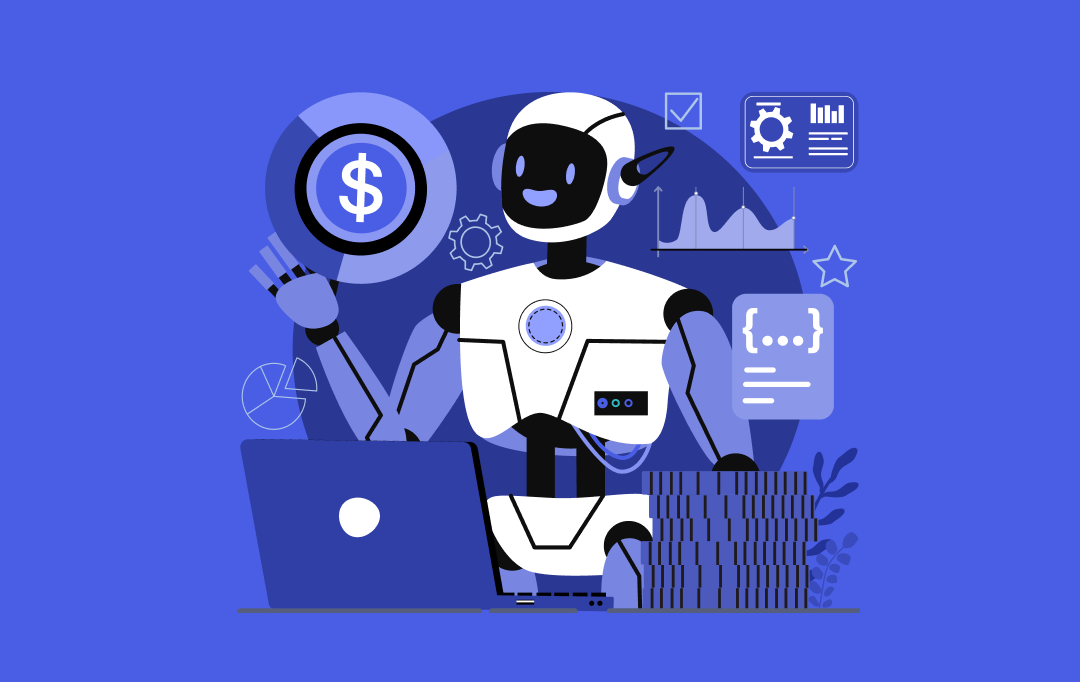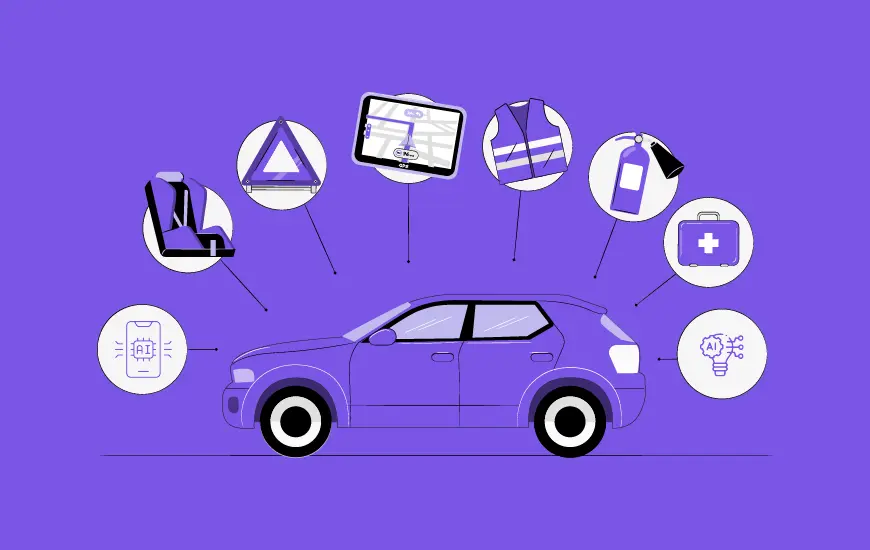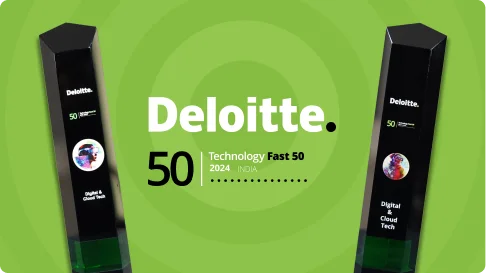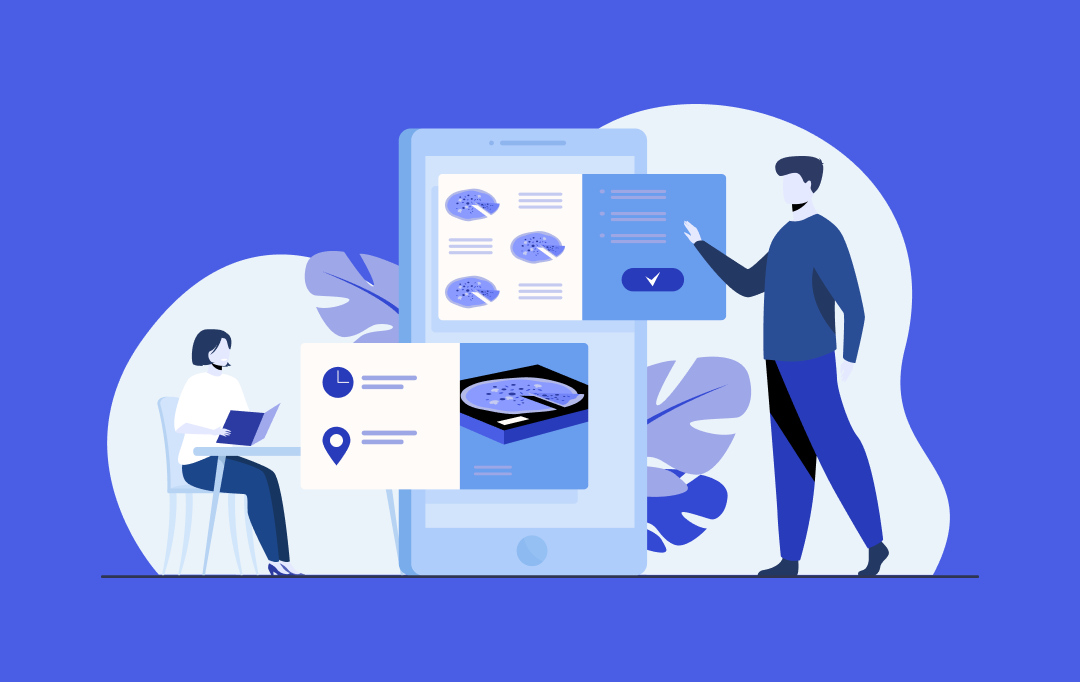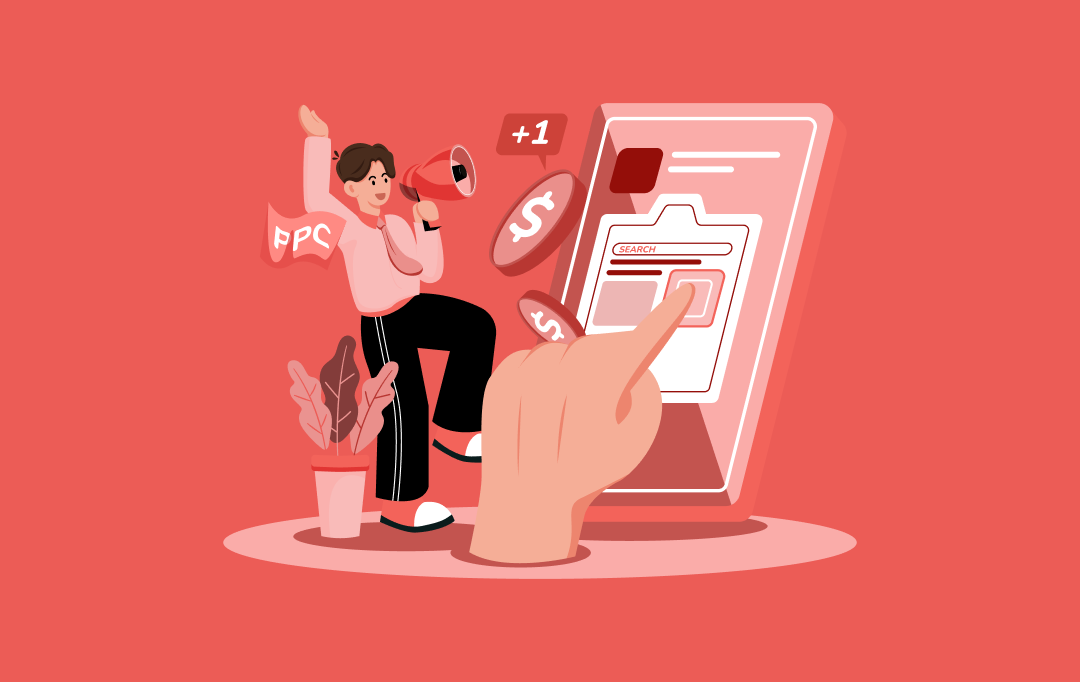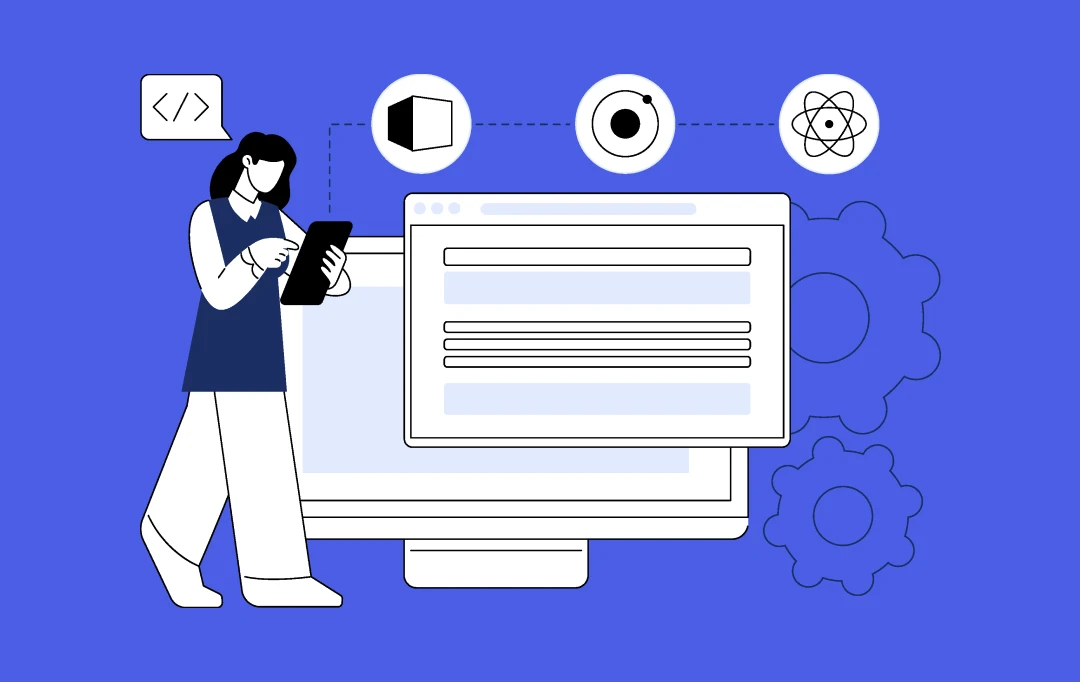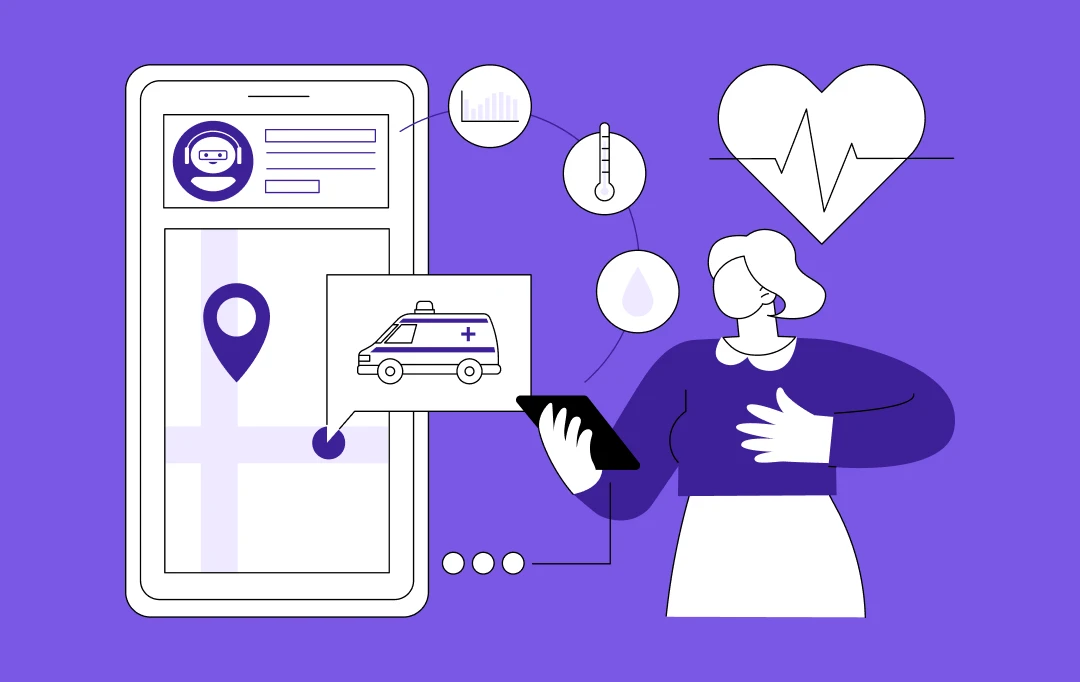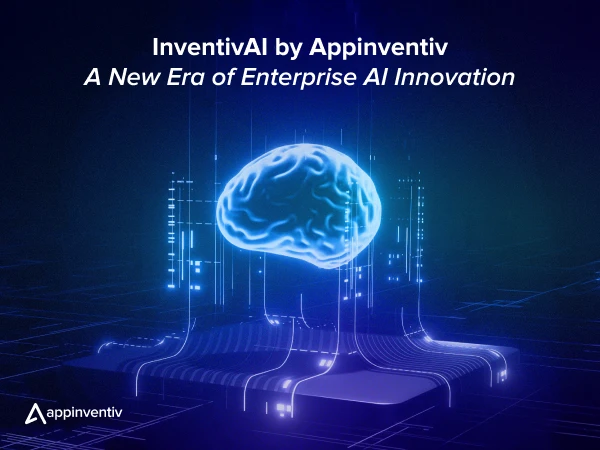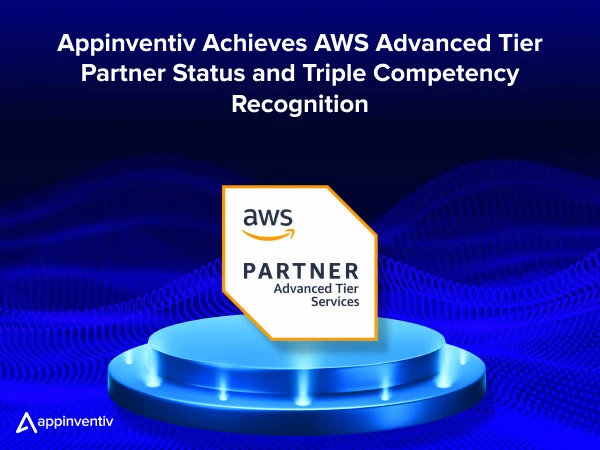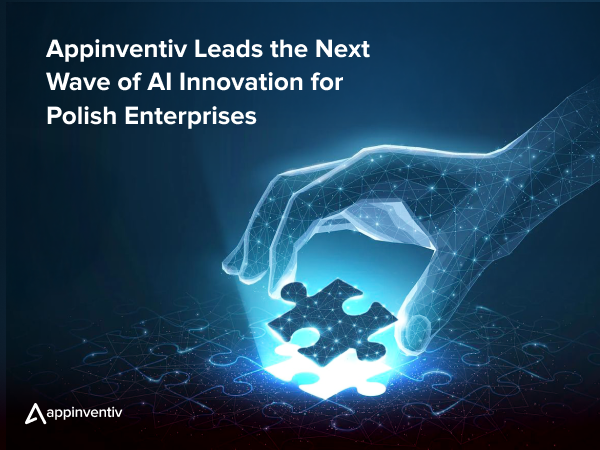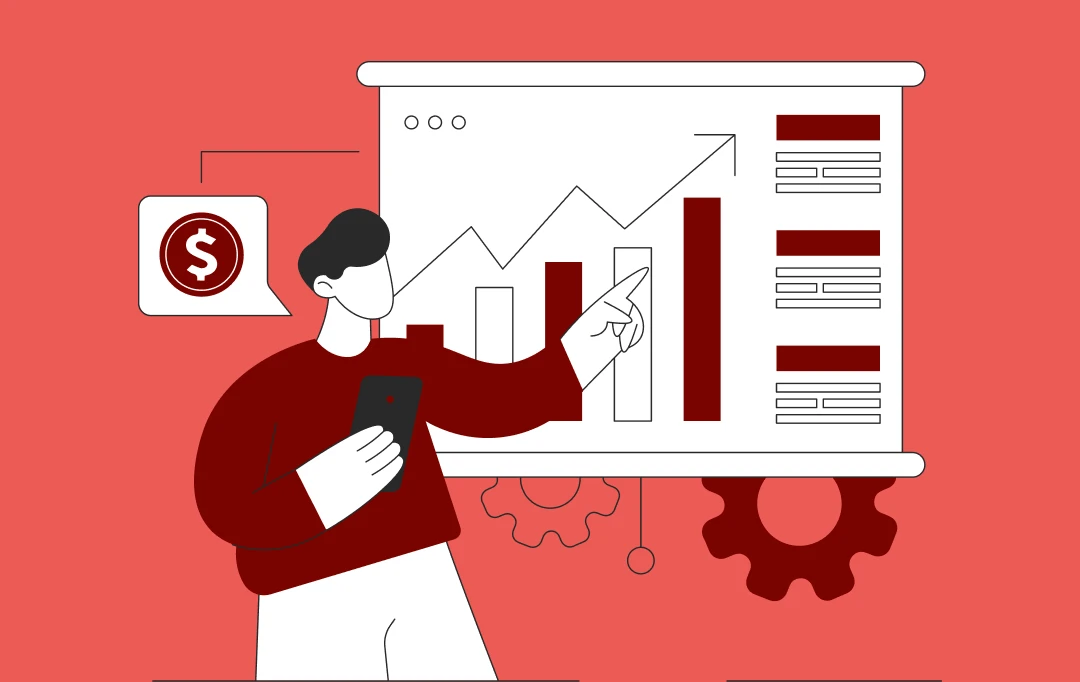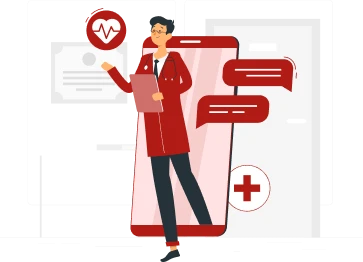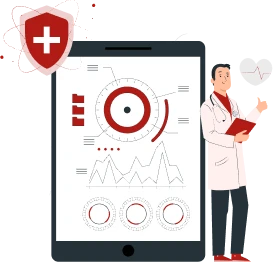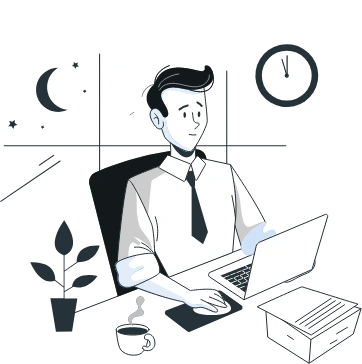- How Does an IoT-Based Remote Patient Monitoring System Work
- Unlocking Value: The Core Benefits of IoT-Based RPM Systems
- Enhanced Patient Engagement and Adherence
- Reduced Hospital Readmissions and Emergency Visits
- Optimized Resource Allocation and Operational Costs
- Improved Chronic Disease Management
- Expanded Access to Care, Especially for Underserved Populations
- Proactive Intervention and Personalized Treatment Plans
- Enhanced Data-Driven Decision Making
- Building Blocks of Excellence: Key Features of an IoT-Based RPM System
- Intuitive Patient-Facing Applications
- Comprehensive Clinician Dashboards
- Real-time Data Collection and Transmission
- Automated Alerts and Notifications
- Seamless Telemedicine Integration
- Integration with Existing EHR/EMR Systems
- Robust Reporting and Analytics Tools
- Advanced Security Protocols
- Scalability and Interoperability
- From Concept to Reality: The Development Process of an IoT-Based RPM System
- Technology Stack Selection
- System Architecture Design
- Sensor Integration
- IoT RPM Software Development
- Data Security and Compliance Implementation
- Testing and Quality Assurance
- Deployment and Go-Live
- Post-Launch Support and Maintenance
- The Investment Blueprint: Understanding the Cost of Developing an IoT-Based RPM System
- Maximizing Returns: Potential for ROI in IoT-Based RPM
- Cost Savings from Reduced Hospitalizations and Emergency Visits
- Increased Revenue Through Expanded Patient Capacity and New Service Offerings
- Improved Patient Satisfaction Leading to Higher Retention Rates
- Enhanced Clinical Efficiency and Optimized Staff Utilization
- Reduced Administrative Burden and Burnout
- Proof in Practice: Real-World Examples & Use Cases of IoT-Based RPM
- Chronic Disease Management (e.g., Diabetes, Hypertension, or Heart Failure):
- Post-operative Care and Rehabilitation
- Elderly Care and Remote Monitoring for Seniors
- Medication Adherence Tracking
- Preventative Health and Wellness Programs
- Challenges and Solutions of IoT-Based RPM Systems
- Data Security and Privacy Concerns
- Interoperability and Integration with Legacy Systems:
- Regulatory Compliance
- Data Overload and Actionable Insights
- Glimpse into Tomorrow Trend: The Future of IoT-enabled remote patient monitoring with AI integration
- Deeper Integration with Artificial Intelligence and Machine Learning for Predictive Analytics
- Advancements in Wearable Technology and Biosensors
- Increased Adoption of 5G for Seamless Connectivity
- Partnering for a Connecting & Healthier Future with Appinventiv
- FAQs
Key takeaways:
- These systems enable continuous, proactive monitoring, leading to better patient outcomes, higher engagement in self-management, and reduced hospital readmissions.
- IoT RPM optimizes healthcare workflows by automating data collection and analysis, freeing up clinical staff and improving the allocation of valuable resources.
- IoT-based RPM system development costs range between $30,000 and $300,000 or more.
- IoT-based RPM system development delivers significant financial returns through reduced costs, increased efficiency, and expanded service capabilities.
Let’s be honest—healthcare decision-makers like you are juggling a lot. Rising costs, pressure to deliver personalized care, and the constant push to improve patient outcomes. It’s a lot, right? What if there were a way to tackle all these challenges without compromising on quality? That’s where the IoT-based remote patient monitoring system comes in.
Picture this: you’re in a busy hospital ward, where every second counts. A team of intensivists is closely watching a patient recovering from a serious cardiac surgery. Then, out of nowhere, an alert pops up—something subtle but important. The patient’s IoT-based remote patient health monitoring system has detected a slight change in their vital signs.
This data, analyzed in real-time by an AI algorithm, flags a potential complication hours before traditional methods would. The clinicians, empowered by this early warning, intervene proactively, adjusting medication and preventing a critical downturn.
This isn’t a futuristic dream; it’s the present reality within healthcare. With IoT and AI working together, clinicians are able to make smarter, faster decisions. By continuously gathering and analyzing data, these technologies help identify risks and offer insights that human cognition alone might miss.
For healthcare businesses, this translates directly into significant gains: reduced readmission rates, optimized resource allocation, and ultimately, a healthier bottom line. This highlights how investing in AI-powered IoT solutions isn’t just about delivering better patient care, but also about securing a profitable future for your enterprise.
Still unsure about how IoT can transform your healthcare business? Don’t worry, we’ve got you covered. In this blog, we’ll dive deep into how IoT-based RPM systems work, their key benefits, examples, the development process, costs, and everything you need to know to make smart decisions to stay ahead in an increasingly competitive market.
How Does an IoT-Based Remote Patient Monitoring System Work
An IoT-based remote patient monitoring system operates by collecting real-time health data from patients using IoT-enabled devices, such as wearable devices and sensors. These devices continuously monitor vital signs, including heart rate, blood pressure, glucose levels, and more. The data is then securely transmitted to healthcare providers’ cloud platforms via secure communication protocols.
Once the data is received, it’s analyzed by AI-driven systems to detect any abnormal trends or potential health risks. Clinicians can access this data via intuitive clinician dashboards, allowing them to make timely decisions and intervene when necessary, all without needing to be physically present.
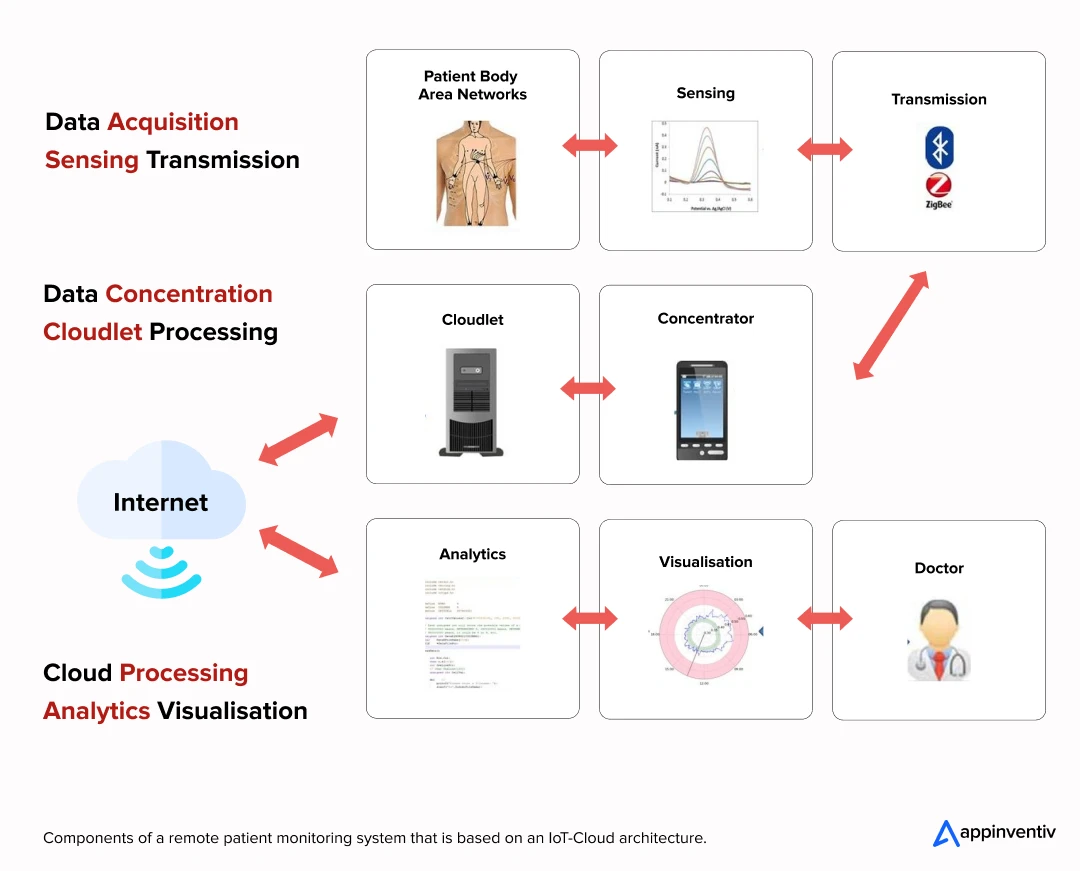
Unlocking Value: The Core Benefits of IoT-Based RPM Systems
The implementation of an IoT-based remote patient monitoring system offers a multitude of tangible benefits that directly impact operational efficiency, patient well-being, and financial health within a healthcare organization. These systems are not merely about collecting data; they are about transforming that data into actionable insights that drive superior outcomes. Here are the measurable benefits of IoT in remote patient monitoring system development:
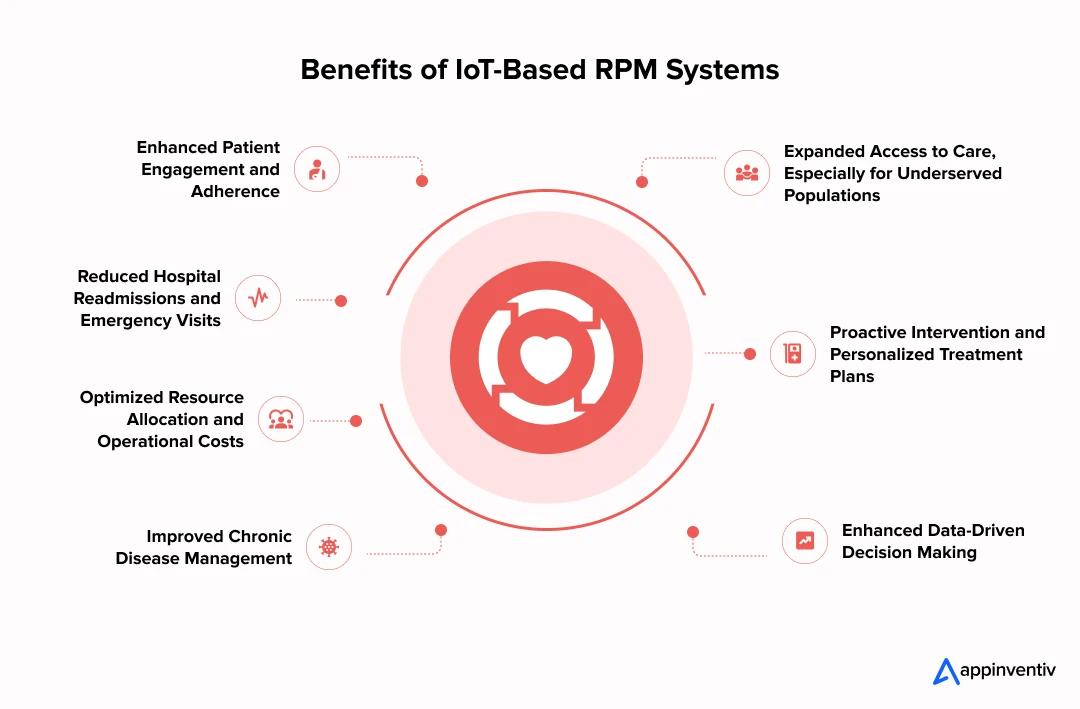
Enhanced Patient Engagement and Adherence
Patients actively participate in their own care by tracking their health metrics and receiving personalized feedback, leading to better adherence to treatment plans and improved self-management of conditions. This proactive involvement fosters a sense of responsibility and partnership in their health journey.
Reduced Hospital Readmissions and Emergency Visits
Continuous monitoring allows for early detection of deteriorating health conditions, enabling timely interventions that prevent acute episodes and reduce the necessity for costly hospitalizations and emergency department visits. This significantly impacts healthcare costs and resource utilization.
Optimized Resource Allocation and Operational Costs
By shifting certain aspects of care from acute settings to the home, healthcare providers can reallocate resources more effectively. RPM reduces the need for frequent in-person appointments, optimizes staff workloads, and can lower operational expenses associated with traditional care models.
Improved Chronic Disease Management
For patients managing chronic conditions like diabetes, hypertension, or heart failure, IoT for remote patient monitoring provides consistent data streams that allow clinicians to fine-tune treatment plans, prevent complications, and ensure long-term stability, leading to a higher quality of life for patients.
Expanded Access to Care, Especially for Underserved Populations
RPM transcends geographical barriers, enabling healthcare access for patients in rural areas or those with mobility challenges. This democratizes healthcare delivery, ensuring that specialized care can reach those who need it most, regardless of their location.
Proactive Intervention and Personalized Treatment Plans
With real-time data and AI-driven analytics, clinicians can move from reactive treatment to proactive intervention. This allows for highly personalized treatment plans tailored to an individual’s unique physiological responses, leading to more effective and efficient care.
Enhanced Data-Driven Decision Making
The rich, continuous data collected by an IoT-based remote health monitoring system provides an unprecedented level of insight into patient health trends. This data empowers clinicians and administrators to make more informed decisions, optimize clinical pathways, and identify areas for systemic improvement within the healthcare system.
Building Blocks of Excellence: Key Features of an IoT-Based RPM System
A truly robust IoT-based remote patient monitoring system is defined by its comprehensive feature set, meticulously designed to meet the complex demands of modern healthcare while ensuring seamless operation and patient safety. These functionalities form the backbone of an effective RPM solution, enabling continuous monitoring, timely intervention, and data-driven insights.
Here are the essential features of an IoT-based remote patient monitoring system that form the backbone of an effective RPM solution:
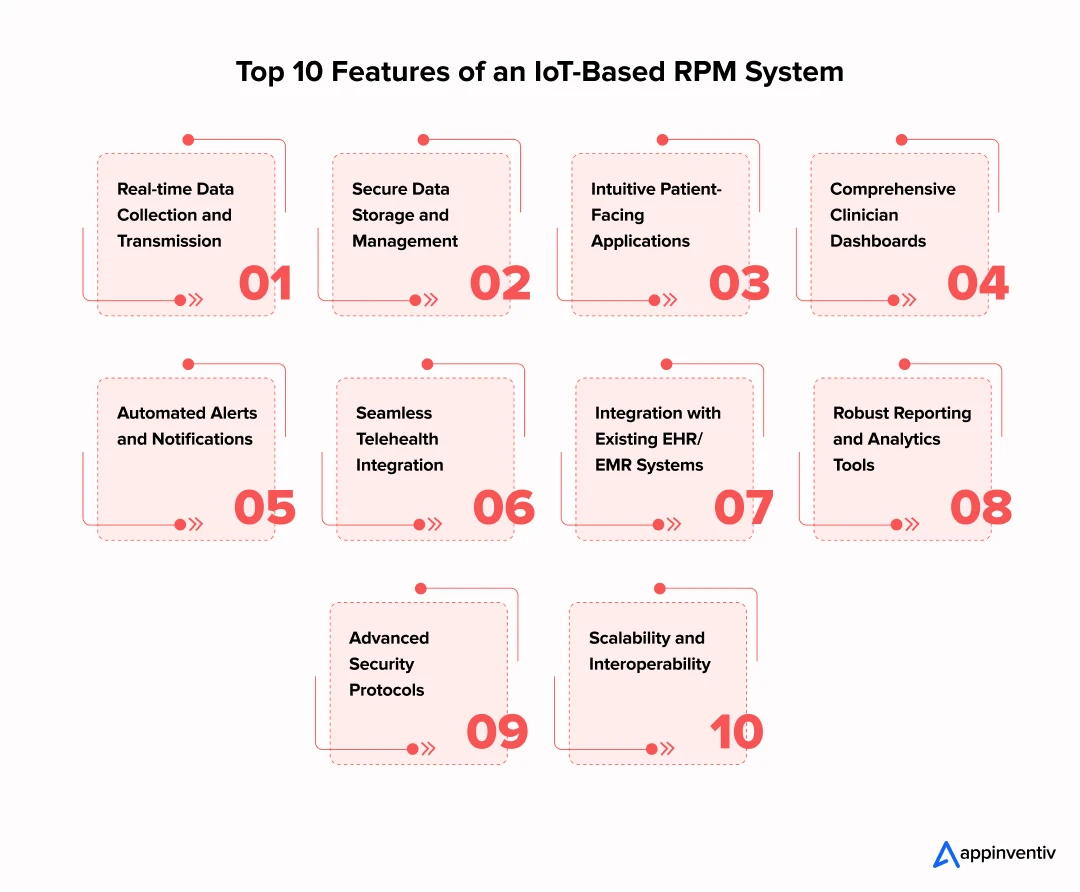 Secure Data Storage and Management
Secure Data Storage and Management
All collected patient data must be stored in a highly secure, encrypted environment that complies with stringent regulatory standards, such as HIPAA in the US and GDPR in Europe. Robust data management ensures integrity, accessibility, and privacy.
Intuitive Patient-Facing Applications
The system should include user-friendly mobile or web applications for patients, allowing them to easily record symptoms, track their progress, communicate with caregivers, and understand their health data without requiring extensive technical knowledge.
Comprehensive Clinician Dashboards
Healthcare providers require centralized, customizable dashboards that offer a holistic view of their patient population. These dashboards display vital trends, alert histories, and medication adherence, and provide tools for secure communication and remote consultations.
Real-time Data Collection and Transmission
The system must efficiently gather vital signs (e.g., heart rate, blood pressure, oxygen saturation), glucose levels, weight, activity data, and other relevant physiological parameters from integrated IoT medical devices and wearables. This data is then securely transmitted to a central platform for analysis.
Appinventiv’s partnership with DiabeticU perfectly exemplifies this. This comprehensive healthcare app for advanced diabetes management seamlessly collects real-time glucose levels and other vital data from connected IoT devices. It ensures this critical information is instantly available for analysis, enabling proactive adjustments to treatment plans and better patient outcomes.
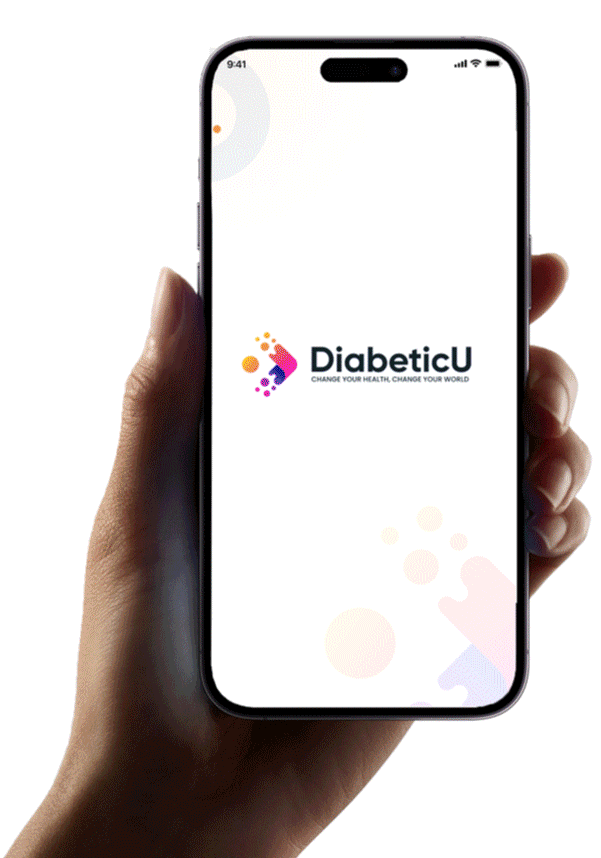
Automated Alerts and Notifications
A critical feature for timely intervention, the system must generate automated alerts to clinicians and caregivers when patient metrics deviate from pre-set thresholds, indicating a potential health risk or emergent situation. These alerts can be configured for various levels of urgency.
Seamless Telemedicine Integration
Modern IoT RPM systems integrate seamlessly with telehealth platforms, enabling secure video and audio consultations between patients and clinicians. This reduces the need for in-person visits, saving time and resources for both parties.
Also Read: AI in Telemedicine: Use Cases, Challenges & Future Trends
Integration with Existing EHR/EMR Systems
To ensure a unified patient record and avoid data silos, an effective IoT remote monitoring system must facilitate secure, bidirectional integration with existing EHR and EMR systems. This provides clinicians with a comprehensive view of patient history and ongoing data.
Robust Reporting and Analytics Tools
Beyond raw data, the system must offer powerful reporting and analytics capabilities. These tools transform collected data into actionable insights, identifying trends, assessing treatment efficacy, and supporting evidence-based clinical decision-making.
Advanced Security Protocols
Given the sensitive nature of health data, robust security protocols are paramount. This includes end-to-end encryption, multi-factor authentication, regular security audits, biometrics, and adherence to industry best practices to protect against cyber threats and unauthorized access.
Scalability and Interoperability
A well-designed IoT-based remote patient monitoring system is built for scalability, capable of accommodating a growing number of patients and devices without compromising performance. Furthermore, it must be interoperable, capable of integrating with other health technologies and platforms as the healthcare ecosystem evolves.
From Concept to Reality: The Development Process of an IoT-Based RPM System
Developing an IoT-based remote patient monitoring system is a complex undertaking that demands a structured, meticulous approach to ensure functionality, security, and compliance. Our extensive experience at Appinventiv reveals that a phased development process of an IoT-based remote patient monitoring system is crucial for transforming a strategic vision into a tangible, impactful solution. This roadmap guides decision-makers through the critical stages, providing clarity and confidence in their investment.
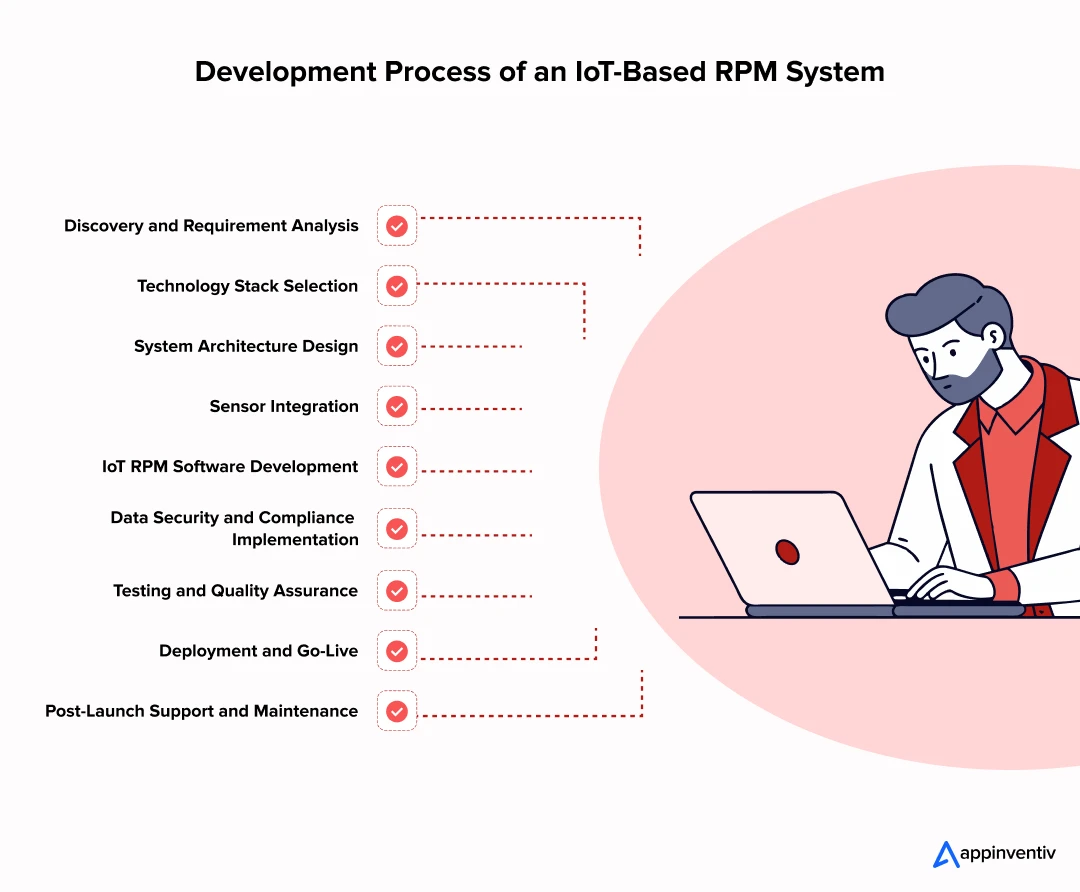 Discovery and Requirement Analysis
Discovery and Requirement Analysis
This foundational phase involves deep dives into your specific healthcare needs, target patient demographics, and desired outcomes. We define the system’s scope, key functionalities, user roles (patients, clinicians, administrators), and integrate regulatory requirements from the outset.
Technology Stack Selection
Choosing the right tech stack is paramount. This involves carefully selecting suitable IoT platforms (e.g., AWS IoT, Azure IoT), communication protocols (e.g., MQTT, Zigbee), sensor technologies, programming languages, and database solutions that align with the system’s performance, security, and scalability needs.
System Architecture Design
Our architects then craft a resilient, scalable, and secure system architecture. This blueprint details how all components – from connected devices and gateways to cloud infrastructure, backend services, and user interfaces – will interact seamlessly and efficiently. This includes outlining the remote patient monitoring IoT architecture for optimal data flow and system stability.
Sensor Integration
This stage focuses on selecting, configuring, and integrating medical-grade IoT devices and sensors that will collect patient data. It involves ensuring the compatibility, accuracy, and reliability of data transmission from various health monitoring devices.
IoT RPM Software Development
This is where the core functionality comes to life. Our teams develop robust backend infrastructure, intuitive patient-facing mobile applications, and comprehensive clinician web dashboards. This includes developing data processing modules, alert systems, communication features, and analytics engines.
Data Security and Compliance Implementation
Security is woven into every layer of the development process. We implement end-to-end encryption, access controls, vulnerability management, and audit trails. Strict adherence to healthcare-specific regulations like HIPAA or GDPR is verified and built in.
Testing and Quality Assurance
Rigorous testing is non-negotiable. This phase encompasses unit testing, integration testing, system testing, performance testing, security testing, and user acceptance testing (UAT). It ensures the system functions flawlessly, securely, and meets all specified requirements under various conditions.
Deployment and Go-Live
Once thoroughly tested, the system is deployed to the chosen cloud environment. This involves careful planning for infrastructure setup, data migration, and a strategic rollout. We also provide comprehensive training for end-users (clinicians and patients) to ensure smooth adoption.
Post-Launch Support and Maintenance
Our commitment extends beyond launch. We provide ongoing support, regular updates, bug fixes, performance monitoring, and necessary enhancements to ensure the system remains optimal, secure, and evolves with changing technological and healthcare needs.
The Investment Blueprint: Understanding the Cost of Developing an IoT-Based RPM System
Investing in an IoT-based remote patient monitoring system is a significant strategic decision that requires a clear understanding of the financial commitment involved. The cost to build an IoT-based remote patient monitoring system is not a fixed sum but rather a dynamic figure influenced by a range of critical factors.
Here are some common factors that influence the development cost of a remote patient monitoring system using IoT:
- Complexity of Features
- Number and Type of Integrated Devices
- Compliance and Security Requirements
- Development Team Size and Location
- Backend Infrastructure and Cloud Services
- Third-Party Integrations
- User Interface (UI) and User Experience (UX) Design
- Testing and Quality Assurance
- Maintenance and Support
While there is no predefined figure for an IoT-based remote patient monitoring system, the average cost of an IoT-based RPM system typically ranges between $30,000 and $300,000, or more.
Maximizing Returns: Potential for ROI in IoT-Based RPM
The financial returns from an IoT-based Remote Patient Monitoring system are not merely theoretical; they are quantifiable and substantial, offering a compelling case for investment in healthcare innovation. For decision-makers, understanding the various avenues through which these systems generate significant return on investment (ROI) is crucial. Our analysis, informed by insights from leading industry reports, clearly demonstrates the profitability of embracing RPM.
Here are the diverse avenues through which healthcare firms can achieve significant ROI:
Cost Savings from Reduced Hospitalizations and Emergency Visits
By enabling proactive care and early intervention, RPM systems drastically reduce the incidence of acute episodes that necessitate expensive hospital stays and emergency department visits.
Increased Revenue Through Expanded Patient Capacity and New Service Offerings
RPM allows healthcare providers to monitor a larger patient base with the same or fewer resources, effectively expanding their capacity and profitability.
Improved Patient Satisfaction Leading to Higher Retention Rates
Patients appreciate the convenience, personalized attention, and sense of security that RPM provides. Higher patient satisfaction translates into increased loyalty, better adherence to care plans, and positive referrals, all contributing to long-term revenue stability.
Enhanced Clinical Efficiency and Optimized Staff Utilization
Automation of data collection and initial analysis frees up clinical staff from manual tasks, allowing them to focus on higher-value activities like patient interaction and critical decision-making. This optimizes their time and reduces administrative burden.
Reduced Administrative Burden and Burnout
Automated data entry and streamlined communication reduce the administrative workload on healthcare staff, leading to decreased burnout and higher job satisfaction, which indirectly impacts operational efficiency and staff retention.
Proof in Practice: Real-World Examples & Use Cases of IoT-Based RPM
The transformative power of IoT-based Remote Patient Monitoring is best illustrated through its practical application across diverse healthcare scenarios. These real-world examples demonstrate how these systems are not just theoretical concepts but are actively driving positive outcomes, improving patient lives, and delivering tangible benefits for healthcare providers.
Here are compelling examples of IoT devices for remote patient monitoring and their successful implementations:
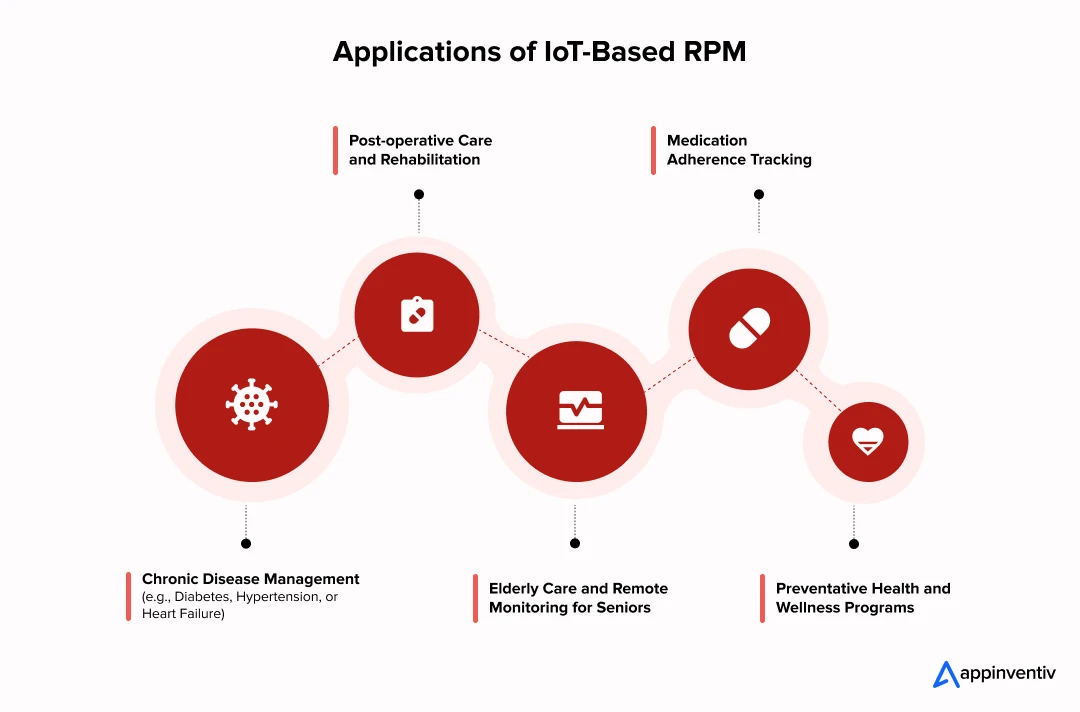
Chronic Disease Management (e.g., Diabetes, Hypertension, or Heart Failure):
Diabetes Management: Patients use IoT-enabled continuous glucose monitors (CGMs) that transmit real-time glucose levels to their care team. Algorithms analyze these readings, flagging trends or dangerous spikes. This enables dietitians and endocrinologists to adjust insulin dosages or dietary recommendations proactively, preventing hyperglycemic or hypoglycemic crises.
Hypertension Monitoring: Individuals with high blood pressure utilize smart blood pressure cuffs that send daily readings to a central platform. When readings are consistently elevated, the system alerts the clinician, who can then initiate a telemedicine consultation to discuss medication adjustments or lifestyle interventions.
Heart Failure Monitoring: Patients wear smart patches or vests that track vital signs, fluid retention, and activity levels. These devices can detect subtle changes that indicate worsening heart failure, triggering alerts for nurses or cardiologists to intervene before a full-blown crisis requiring hospitalization.
Post-operative Care and Rehabilitation
After surgery, patients often require close monitoring to prevent complications and ensure proper recovery. IoT sensors can track incision site temperature, movement, and pain levels. For example, a patient recovering from knee surgery might use a wearable that monitors range of motion, providing physical therapists with real-time data to adjust exercise plans remotely and ensure adherence.
Elderly Care and Remote Monitoring for Seniors
For aging populations, RPM offers a crucial layer of safety and peace of mind. Wearable fall detection devices automatically alert caregivers in case of a fall. Smart home sensors can monitor activity patterns, sleep quality, and even stove usage, providing insights into a senior’s well-being and identifying potential risks without invading their privacy.
Medication Adherence Tracking
Smart pill dispensers or bottle caps with integrated sensors remind patients to take their medication and record when doses are taken. This data is transmitted to clinicians, who can identify non-adherence patterns and intervene with targeted education or support, significantly improving treatment efficacy for chronic conditions.
Preventative Health and Wellness Programs
Beyond managing existing conditions, RPM plays a vital role in preventive care. Corporate wellness programs use wearables to track employee activity, sleep, and stress levels, providing personalized health coaching. This proactive approach helps individuals make healthier lifestyle choices, reducing the long-term burden of preventable diseases.
These examples underscore the versatility and profound impact of IoT-based RPM systems, moving healthcare towards a more proactive, personalized, and efficient model. This highlights the diverse application of IoT in remote patient monitoring.
Challenges and Solutions of IoT-Based RPM Systems
While the promise of IoT-based Remote Patient Monitoring is immense, its successful implementation is not without its challenges. For healthcare decision-makers, understanding these hurdles and having clear strategies for overcoming them is critical for maximizing investment and ensuring seamless operation. At Appinventiv, our experience has equipped us with the knowledge to anticipate these obstacles and provide robust solutions.
Here are the key challenges and their effective solutions:
Data Security and Privacy Concerns
Challenge: The highly sensitive nature of patient health information (PHI) makes IoT-RPM systems prime targets for cyberattacks and data breaches. Ensuring compliance with strict regulations like GDPR and HIPAA is paramount.
Solution: Implement end-to-end encryption for all data in transit and at rest. Utilize multi-factor authentication, regular penetration testing, and vulnerability assessments. Partner with development firms that have a proven track record in building secure healthcare solutions and maintaining robust compliance frameworks. This addresses how secure IoT remote patient monitoring is.
Interoperability and Integration with Legacy Systems:
Challenge: Many healthcare organizations operate with disparate legacy systems (EHR/EMR, billing, lab systems) that are not designed to communicate seamlessly with modern IoT platforms, leading to data silos and inefficient workflows.
Solution: Adopt standardized communication protocols (e.g., HL7, FHIR) for data exchange. Develop robust APIs (Application Programming Interfaces) to facilitate seamless integration between the RPM system and existing legacy infrastructure. A phased integration approach can minimize disruption.
Regulatory Compliance
Challenge: Navigating the complex and evolving landscape of healthcare regulations (e.g., FDA clearance for medical devices, regional privacy laws) can be daunting and time-consuming.
Solution: Engage legal and compliance experts early in the development process. Partner with a development company that has deep experience in regulated industries and can guide you through the necessary certifications and documentation required for medical device classification and data handling.
Data Overload and Actionable Insights
Challenge: The sheer volume of data generated by continuous monitoring can overwhelm clinicians, making it difficult to extract meaningful, actionable insights and leading to alert fatigue.
Solution: Implement AI and Machine Learning algorithms to filter noise, prioritize critical alerts, and identify significant trends. Develop intuitive dashboards that present data in a clear, summarized, and actionable format, allowing clinicians to focus on anomalies rather than raw data.
Glimpse into Tomorrow Trend: The Future of IoT-enabled remote patient monitoring with AI integration
The landscape of IoT in healthcare is in constant flux, evolving at a rapid pace fueled by technological breakthroughs and a growing demand for more efficient and personalized care. For decision-makers, understanding these emerging trends and innovations is crucial for strategic planning and ensuring that your investments in IoT-based RPM systems are future-proof.
Here are the key trends and innovations shaping the future of IoT in healthcare:
Deeper Integration with Artificial Intelligence and Machine Learning for Predictive Analytics
The synergy between IoT and AI will intensify. Beyond mere data collection, applications of AI in healthcare will be pivotal in predicting health crises, identifying subtle disease progression, and offering personalized treatment recommendations based on vast datasets. Expect advanced algorithms capable of forecasting events like heart attacks or diabetic complications with higher accuracy.
Advancements in Wearable Technology and Biosensors
Wearable applications will become even more sophisticated, moving beyond basic vital signs to offer continuous, non-invasive monitoring of a wider range of biomarkers, including blood glucose, lactate, and even certain neurotransmitter levels. Miniaturization and increased comfort will drive greater patient adoption.
Increased Adoption of 5G for Seamless Connectivity
The widespread rollout of 5G will dramatically enhance the capabilities of IoT in healthcare. Its high bandwidth and ultra-low latency will enable real-time transmission of large medical datasets, support high-definition telemedicine, and facilitate the operation of complex remote surgical tools.
These trends signify a future where healthcare is more proactive, personalized, and accessible, fundamentally transforming the patient experience and the operational efficiency of healthcare organizations.
Also Read: Innovative Technology Changing the Healthcare Sector
Don’t wait—take the first step toward smarter, more efficient patient care with IoT RPM.
Partnering for a Connecting & Healthier Future with Appinventiv
The shift towards IoT-based remote patient monitoring is not merely an option; it is a strategic imperative for healthcare organizations seeking to deliver superior patient outcomes and achieve sustainable growth. The data clearly demonstrates the unparalleled value in terms of cost reduction, revenue generation, and enhanced patient care.
Appinventiv, as a leading provider of healthcare software development services, understands the intricate complexities of this technological evolution and the critical need for secure, scalable, and compliant solutions. With our proven expertise in developing healthcare and remote patient monitoring systems using IoT, we empower businesses to build secure, scalable, and impactful RPM systems that truly transform patient care and drive significant ROI.
We possess the technical prowess, regulatory understanding, and creative vision to transform your strategic objectives into tangible, high-performing digital health solutions. Our commitment to innovation is evident in our successful healthcare projects, demonstrating our ability to deliver tailored, cutting-edge platforms for healthcare:
- Soniphi: Our partnership with Soniphi resulted in the creation of the first vitality app for health tracking and analysis through sound.
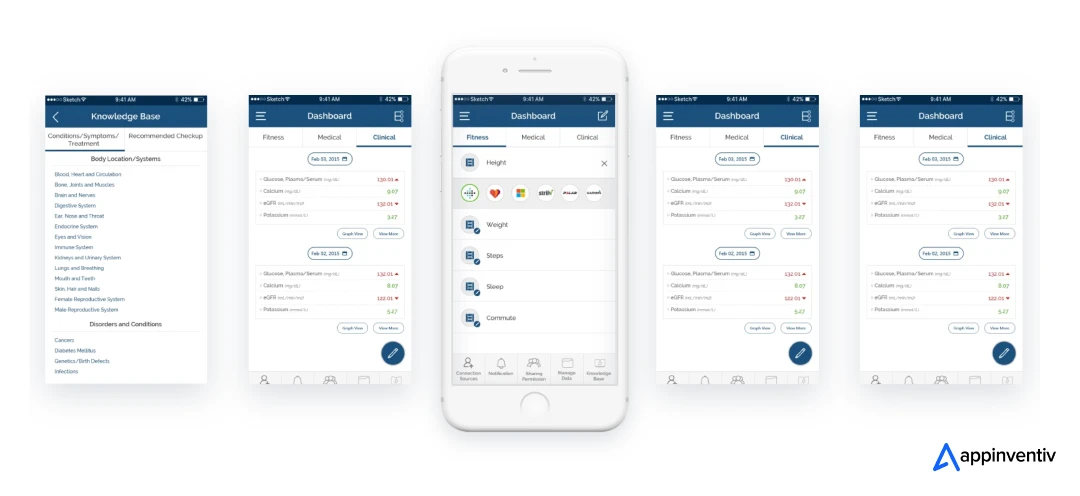
- Health-e-People: Our healthcare app developers built Health-e-People, a robust digital health ecosystem, which fosters comprehensive patient care and engagement.
These case studies underscore our ability to deliver tailored, cutting-edge IoT solutions that meet diverse healthcare needs. From initial concept to post-launch support, we stand by you as your dedicated tech partner in navigating this transformative journey. This exemplifies our strong IoT software development services.
Contact us now and let’s build the future of healthcare together.
FAQs
Q. What is an IoT-based remote patient monitoring system?
A. An IoT-based Remote Patient Monitoring system utilizes connected devices and sensors to collect patient health data outside of traditional clinical settings, transmitting it securely to healthcare providers for continuous monitoring, analysis, and proactive intervention.
Q. How much does it cost to develop an IoT-based monitoring app?
A. The cost of IoT app development for RPM varies significantly based on several factors, such as features, device integration, compliance needs, and development team location. On average, the cost to build an IoT-based remote patient monitoring system will range from $30,000 to $200,000, while a comprehensive platform with advanced features and technologies will cost between $200,000 and $300,000 or more.
Q. How long does it take to develop an IoT-based RPM system?
A. The time required for IoT remote patient monitoring system development ranges between 4 months and 1 year or more, depending on various elements.
Contact us to get a precise estimate for the IoT remote patient monitoring system development timeline and cost.
Q. Which technologies are used in IoT remote health monitoring?
A. The technologies used in IoT and remote health monitoring include:
- IoT-Enabled Wearables and Sensors
- Adoption of Cloud Computing
- AI and Machine Learning
- Telemedicine Platforms
- Secure Communication Protocols
These technologies work together to create a comprehensive IoT remote health monitoring system, allowing continuous patient monitoring outside of traditional hospital settings.
Q. Is IoT remote patient monitoring secure?
A. Yes, IoT remote patient monitoring systems are designed with security as a top priority. These systems use a combination of end-to-end encryption, multi-factor authentication, and regular security audits to protect sensitive patient data.
Moreover, remote patient monitoring in hospitals adheres to essential compliances and relies on strong interoperability with existing hospital systems, which are also secured to prevent data breaches.
Q. Why are healthcare providers investing in remote patient monitoring systems?
A. Healthcare providers are increasingly investing in IoT-based remote patient monitoring systems because of the significant benefits they bring to patient care and operational efficiency. These systems enable continuous monitoring, offering healthcare providers real-time data about a patient’s condition without requiring them to be physically present. This leads to:
- Early Detection and Proactive Care
- Cost Reduction:
- Improved Patient Outcomes
- Increased Patient Engagement
- Future-Proofing Healthcare
To gain an in-depth understanding of the Importance of IoT-based remote patient monitoring systems, please refer to the above blog.


- In just 2 mins you will get a response
- Your idea is 100% protected by our Non Disclosure Agreement.
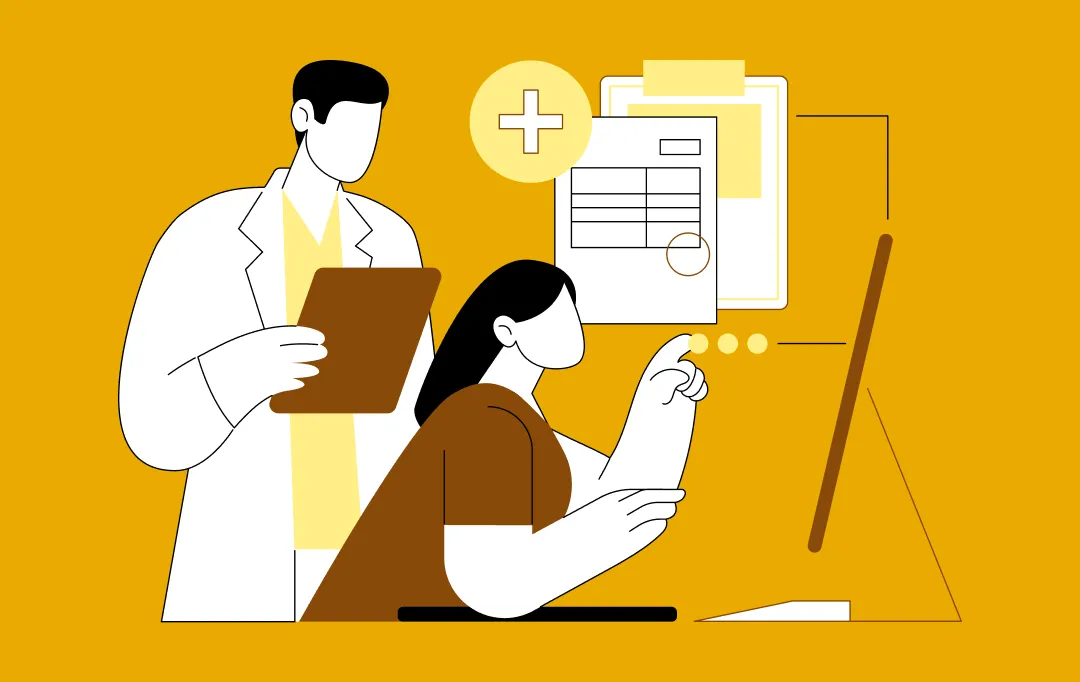
How Much Does It Cost to Build a Healthcare App in Saudi Arabia? All You Need to Know
Key takeaways: Healthcare app costs in Saudi Arabia range from 112,500 SAR to 2,250,000+ SAR based on size and complexity. The type of app you build matters more to cost than anything else. Compliance, security, and scalability are built into the cost, not add-ons. Development and testing consume the largest share of the budget. Hidden…

How Prescriptive Analytics Is Shaping the Future of Healthcare Management
A healthcare business doesn’t fall behind because its teams lack skill. It falls behind when decisions take too long. Bed allocation runs on yesterday’s data. Procurement reacts only when shortages hit. Care managers step in after a patient is already at risk. And leadership gets a picture of what’s happening only after the quarter closes,…
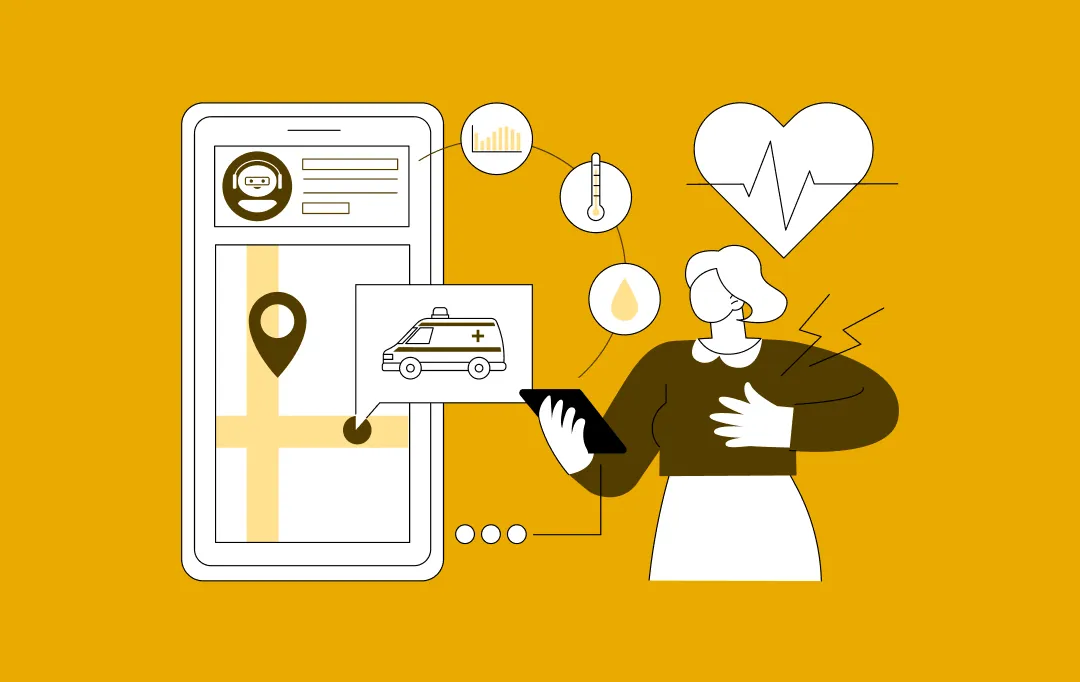
How to Build an Urgent Care App? A Step-by-Step Process, Features and Costs
Key takeaways: With more people turning to digital healthcare, the urgent care app market is expected to touch $3.1 billion by 2024 and continue growing fast through 2030. Apps that offer easy scheduling, video consultations, EHR access, and quick insurance handling tend to attract more users and keep them coming back. Developing an urgent care…
